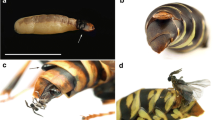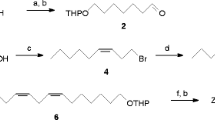Abstract
The sex pheromone of the red banded mango caterpillar, Deanolis sublimbalis (Lepidoptera: Crambidae), a serious pest of the mango Mangifera indica (Anacardiaceae) in India and Southeast Asia and a recent invader into northern Australia, has been identified. Three candidate compounds were identified from pheromone gland extracts of female moths, using gas chromatography (GC), GC-electroantennographic detection and GC-mass spectrometric analyses, in conjunction with dimethyldisulfide derivatization. Field bioassays established that both (Z)-11-hexadecenal (Z11-16:Ald) and (3Z,6Z,9Z)-tricosatriene (3Z,6Z,9Z-23:Hy) were required for attraction of male D. sublimbalis moths, and 1,000 μg of a 1:1 mix of Z11-16:Ald and 3Z,6Z,9Z-23:Hy was more attractive to male moths than caged virgin females. However, the binary blend was only attractive when the isomeric purity of the monounsaturated aldehyde was >99%, suggesting that the (E)-isomer was inhibitory. Although (Z)-11-hexadecen-1-ol (Z11-16:OH) was tentatively identified in gland extracts, the addition of this compound to the binary blend did not increase the numbers of moths captured. The pheromone can now be used in integrated pest management strategies.



Similar content being viewed by others
References
AMIA. 2006. Australian Mango Industry Association Ltd. Website accessed 5th June, 2006. http://www.mangoes.net.au/general/industry_profile/.
Ando, T., Inomata, S., and Yamamoto, M. 2004. Lepidopteran sex pheromones, pp. 51–96, in S. Schulz (ed.). The Chemistry of Pheromones and Other Semiochemicals I: Topics in Current Chemistry 239. Springer, Berlin, Heidelberg New York.
Bell, T. W. and Meinwald, J. 1986. Pheromones of two arctiid moths (Creatonotos transiens and C. gangis): chiral components from both sexes and achiral female components. J. Chem. Ecol. 12:385–409.
Buser, H., Arn, H., Guerin, P., and Rauscher, S. 1983. Determination of double bond position in mono-unsaturated acetates by mass spectrometry of dimethyl disulfide adducts. Anal. Chem. 55:818–822.
Cabrera, A., Eiras, A., Gries, G., Gries, R., Urdaneta, N., Miras, B., Badji, C., and Jaffe, K. 2001. Sex pheromone of tomato fruit borer, Neoleucinodes elegantalis. J. Chem. Ecol. 27:2097–2107.
Clare, G., Suckling, D. M., Bradley, S. J., Walker, J. T. S., Shaw, P. W., Daly, J. M., McLaren, G. F., and Wearing, C. H. 2000. Pheromone trap colour determines catch of non-target insects. N. Z. Plant Prot. 53:216–220.
El-Sayed, A. M. 2006. The Pherobase: Database of Insect Pheromones and Semiochemicals. http://www.pherobase.com.
Foulis, S. L. 2000. Red Banded Mango Caterpillar Contingency Plan, December 2000. Animal and Plant Health Service, Department of Primary Industries. Queensland, Cairns.
Gibb, A. R., Comeskey, D., Berndt, L., Brockerhoff, E. G., El-Sayed, A. M., Jactel, H., and Suckling, D. M. 2006. Identification of sex pheromone components of a New Zealand geometrid moth, the common forest looper Pseudocoremia suavis, reveals a possible species complex. J. Chem. Ecol. 32:865–879.
Golez, H. G. 1991. Bionomics and control of the mango seed borer, Noorda albizonalis Hampson (Pyralidae, Lepidoptera) [=Deanolis sublimbalis Snellen]. Acta Hortic. 291:418–424.
Jurenka, R. 2004. Insect pheromone biosynthesis, pp. 97–131, in S. Schulz (ed.). The Chemistry of Pheromones and Other Semiochemicals I: Topics in Current Chemistry 239. Springer, Berlin, Heidelberg New York.
Kováts, E. 1965. Gas chromatographic characterization of organic substances in the retention index system, pp. 229–247, in J. C. Giddings and R. A. Keller (eds.). Advances in Chromatography, Vol. 1. Edward Arnold Ltd., London.
Krull, S. M. E. 2004. Studies on the mango-ecosystem in Papua New Guinea with special reference to the ecology of Deanolis sublimbalis Snellen (Lepidoptera, Pyralidae) and to the biological control of Ceroplastes rubens Maskell (Homoptera, Coccidae). PhD thesis, Justus-Liebeg-Universität, Giessen, Germany. http://geb.uni-giessen.de/geb/volltexte/2004/1428/.
Leal, W. S., Parra-Pedrazzoli, A. L., Kaissling, K. E., Morgan, T. I., Zalom, F. G., Pesak, D. J., Dundulis, E. A., Burks, C. S., and Higbee, B. S. 2005. Unusual pheromone chemistry in the navel orangeworm: novel sex attractants and a behavioral antagonist. Naturwissenschaften 92:139–146.
Leonhardt, B. A. and DeVilbiss, E. D. 1985. Separation and double-bond determination on nanogram quantities of aliphatic monounsaturated alcohols, aldehydes and carboxylic methyl esters. J. Chromatogr. 322:484–490.
Li-Ying, L., Ren, W., and Waterhouse, D. F. 1997. The Distribution and Importance of Arthropod Pests and Weeds of Agriculture and Forestry Plantations in Southern China. ACIAR Monograph No. 46, Canberra, Australia. 185 pp.
Marques, F. A., McElfresh, J. S., and Millar, J. G. 2000. Kováts retention indexes of monounsaturated C12, C14, and C16 alcohols, acetates, and aldehydes commonly found in lepidopteran pheromone blends. J. Braz. Chem. Soc. 11:592–599.
Millar, J. G. 2000. Polyene hydrocarbons and epoxides: a second major class of lepidopteran sex attractant pheromones. Annu. Rev. Entomol. 45:575–604.
Millar, J. G., Grant, G. G., McElfresh, J. S., Strong, W., Rudolph, C., Stein, J. D., and Moreira, J. A. 2005. (3Z,6Z,9Z,12Z,15Z)-Pentacosapentaene, a key pheromone component of the fir coneworm moth, Dioryctria abietivorella. J. Chem. Ecol. 31:1229–1234.
Suckling, D. M. 2000. Issues affecting the use of pheromones and other semiochemicals in orchards. Crop Prot. 19:677–683.
Sujatha, A. and Zaheruddeen, S. M. 2002. Biology of pyralid fruit borer, Deanolis albizonalis Hampson [=Deanolis sublimbalis Snellen]: a new pest of mango. J. Appl. Zool. Res. 13:1–5.
Underhill, E. W., Palaniswamy, S. R., Abrams, S. R., Bailey, B. K., Steck, W. F., and Chisolm, M. D. 1983. Triunsaturated hydrocarbons, sex pheromone components of Caenurgina erechtea. J. Chem. Ecol. 9:1413–1423.
Waterhouse, D. F. 1993. The Major Arthropod Pests and Weeds of Agriculture in Southeast Asia. ACIAR Monograph No. 21, Canberra, Australia. 141 pp.
Waterhouse, D. F. 1998. Biological Control of Insect Pests: South East Asian Prospects. ACIAR Monograph No. 51, Canberra, Australia. 548 pp.
Acknowledgement
We thank Sine Gelua for technical assistance with rearing insects and field bioassays and Adam Matich and Andréa Stephens for commenting on an earlier version of the manuscript. Funding was provided by the Australian Center for International Agriculture Research (ACIAR), Horticulture Australia Ltd (HAL), Growcom (formerly Queensland Fruit and Vegetable Growers Association), and the New Zealand Foundation for Research, Science and Technology (FRST), under “Better Border Biosecurity” and previous programmes, to develop scientific capability to respond to biosecurity incursions.
Author information
Authors and Affiliations
Corresponding author
Electronic Supplementary Material
Below is the link to the electronic supplementary material.
Supplementary 1
(DOC 130 kb)
Rights and permissions
About this article
Cite this article
Gibb, A.R., Pinese, B., Tenakanai, D. et al. (Z)-11-Hexadecenal and (3Z,6Z,9Z)-Tricosatriene: Sex Pheromone Components of the Red Banded Mango Caterpillar Deanolis sublimbalis . J Chem Ecol 33, 579–589 (2007). https://doi.org/10.1007/s10886-006-9221-x
Received:
Accepted:
Published:
Issue Date:
DOI: https://doi.org/10.1007/s10886-006-9221-x




